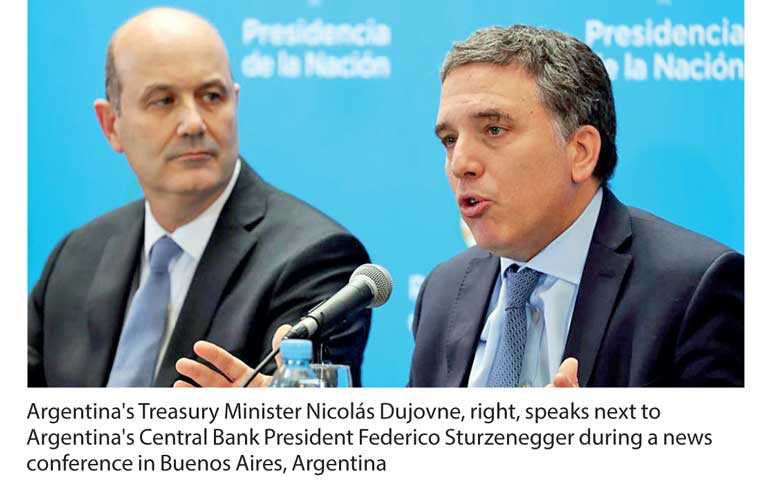Monday Dec 01, 2025
Monday Dec 01, 2025
Monday, 11 June 2018 00:00 - - {{hitsCtrl.values.hits}}
 BUENOS AIRES (Reuters): Argentina and the International Monetary Fund reached an agreement last week for a three-year, $50 billion standby lending arrangement, which the Government said it sought to provide a safety net and avoid the frequent crises of the country’s past.
BUENOS AIRES (Reuters): Argentina and the International Monetary Fund reached an agreement last week for a three-year, $50 billion standby lending arrangement, which the Government said it sought to provide a safety net and avoid the frequent crises of the country’s past.
Argentina requested IMF assistance on 8 May after its peso currency weakened sharply in an investor exodus from emerging markets. As part of the deal, which is subject to the IMF Board approval, the Government pledged to speed up plans to reduce the fiscal deficit even as authorities now foresee lower growth and higher inflation in the coming years.
The deal marks a turning point for Argentina, which for years shunned the IMF after a devastating 2001-2002 economic crisis that many Argentines blamed on IMF-imposed austerity measures. President Mauricio Macri’s turn to the lender has led to protests in the country.
“There is no magic. The IMF can help, but Argentines need to resolve our own problems,” Treasury Minister Nicolás Dujovne said at a news conference.
Dujovne said he expected the IMF’s Board to approve the deal during a 20 June meeting. After that, he said he expects an immediate disbursement of 30% of the funding, or about $ 15 billion.
Argentina will seek to reduce its fiscal deficit to 1.3% of gross domestic product in 2019, down from 2.2% previously, Dujovne said. The deal calls for fiscal balance in 2020 and a fiscal surplus of 0.5% of GDP in 2020.
“This measure will ultimately lessen the government financing needs, put public debt on a downward trajectory and, as President Macri has stated, relieve a burden from Argentina’s back,” IMF Managing Director Christine Lagarde said in a statement.
Speaking alongside Central Bank Governor Federico Sturzenegger, Dujovne noted that the agreement was well above Argentina’s IMF quota. A minimum $20 billion had been expected based on Argentina’s quota.
The interest rate will be from 1.96-4.96%, depending on how much Argentina uses. The South American country must pay back each disbursement in eight quarterly instalments, with a three-year grace period. As widely expected, the Government will also send a proposal to Congress to reform the Central Bank’s charter and strengthen its autonomy. The Central Bank will also stop transferring money to the treasury, a practice known locally as the “little machine” that is seen as a major driver of incessant inflation.
“The little machine has been turned off. It has been unplugged,” Sturzenegger said.
The IMF’s backing was expected to boost Argentine assets, which have sagged in recent months amid a global sell-off in emerging markets. Neighbouring Brazil, Latin America’s largest economy, has also seen its currency weaken in recent days to its lowest level in more than two years on fears over the county’s fiscal outlook and political future.
But, the short-term economic picture for Argentina remains more complicated than it appeared several months ago. Dujovne said economic growth was expected at 1.4% for 2018, and between 1.5% and 2.5% for 2019, down from prior expectations of above 3% in both years.
The Central Bank will also abandon its 2018 inflation target of 15% and will not target any particular level this year, Sturzenegger said. Argentina agreed to new, looser inflation targets of 17% for 2019, 13% for 2020 and 9% for 2021, down from 25% currently.
Both Argentina and the IMF said the deal would protect the most vulnerable.
In a separate statement, the President’s Office said it had clinched agreements for an additional $ 5.65 billion from the Inter-American Development Bank, the World Bank and the CAF Development Bank over the next 12 months.